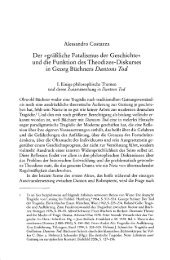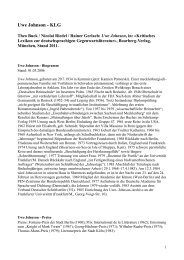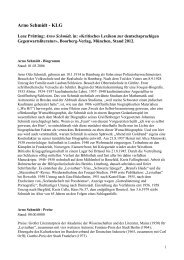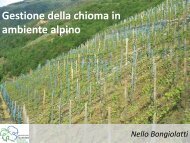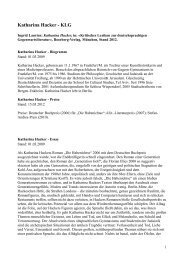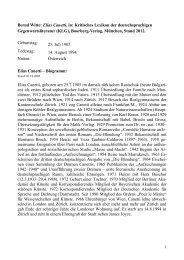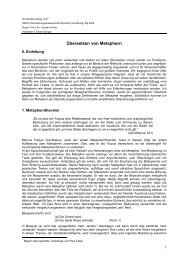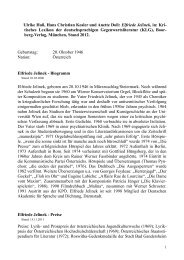Volume of Abstracts - Università degli Studi di Milano
Volume of Abstracts - Università degli Studi di Milano
Volume of Abstracts - Università degli Studi di Milano
You also want an ePaper? Increase the reach of your titles
YUMPU automatically turns print PDFs into web optimized ePapers that Google loves.
5 th Int. Workshop on Ice Caves (IWIC – V)<br />
Barzio (LC), Valsassina, Grigna and <strong>Milano</strong>, September 16 – 23, 2012<br />
<strong>Volume</strong> <strong>of</strong> <strong>Abstracts</strong><br />
ASSESSING THE PALAEOCLIMATE POTENTIAL OF THE A294 ICE<br />
CAVE (CENTRAL PYRENEES, NORTHERN SPAIN)<br />
Belmonte, A. 1 , Bartolomé, M. 1,2 , Sancho, C. 1 , Moreno, A. 2 & López-<br />
Martínez, J. 3<br />
1 Departamento de Ciencias de la Tierra, Universidad de Zaragoza, Pedro Cerbuna 12, 50009<br />
Zaragoza, Spain. (anchelbr@unizar.es, csancho@unizar.es, mbartolomeucar@hotmail.com)<br />
2 Departamento de Procesos Geoambientales y Cambio Global, Instituto Pirenaico de Ecología,<br />
C.S.I.C., Avda. Montañana 1005, 50059 Zaragoza, Spain. (amoreno@ipe.csic.es)<br />
3 Departamento de Geología y Geoquímica, Facultad de Ciencias, Universidad Autónoma de Madrid,<br />
28049 Madrid, Spain. (jeronimo.lopez@uam.es)<br />
Occurrence <strong>of</strong> perennial ice in limestone caves from the southern side <strong>of</strong><br />
the Pyrenees is not uncommon. However, although ice caves in this<br />
mountain range were explored many decades ago, sparse attention has<br />
been paid to the study <strong>of</strong> the ice records. The aim <strong>of</strong> this work is to assess<br />
the palaeoclimate potential <strong>of</strong> the A294 ice cave, a small ice cave located<br />
at 2238 m a.s.l. in the Cotiella karstic massif in the Spanish Central<br />
Pyrenees. Temperature monitoring in<strong>di</strong>cates an input <strong>of</strong> cold air during the<br />
winter, while there is no air circulation in summer. General melting<br />
con<strong>di</strong>tions prevail during summer season. The bottom <strong>of</strong> the cave houses<br />
an ice deposit almost 10 meters thick and 125 m 3 in volume. Most <strong>of</strong> the<br />
ice comes from freezing <strong>of</strong> the snow that enters the cave through the<br />
entrance. Ice body shows a stratified structure with several inner debris<br />
layers inclu<strong>di</strong>ng many vegetal remnants. A precise chronological model <strong>of</strong><br />
the ice section, based on ra<strong>di</strong>ocarbon calibrated ages, has been<br />
established, demonstrating a very high stratigraphic consistence covering<br />
from 6208-5992 cal. yr BP at the bottom, to 2060-1895 cal. yr BP at the<br />
top. As a consequence, it is one <strong>of</strong> the oldest subsurface ice deposits<br />
known so far in Europe. A cycle <strong>of</strong> 500-yr in the ice accumulation rate is<br />
observed, reaching maximum values <strong>of</strong> 0.34 cm/year and minimum <strong>of</strong> 0.04<br />
cm/year. On the other hand, preliminary stable isotopic data (δ 18 O and δ 2 D<br />
measured in the ice) fit closely to the global meteoric water line confirming<br />
the origin <strong>of</strong> the ice. The δ 18 OVSMOW values range from -12.93 to -8.01 ‰<br />
showing a high variability during the intervals with high ice accumulation<br />
rates, such as the Middle Holocene, that correspond to cold palaeoclimatic<br />
con<strong>di</strong>tions. In ad<strong>di</strong>tion, isotopic data oscillations provide information <strong>of</strong><br />
temperature variations at a centennial/decadal scale. Summarizing, after<br />
this preliminary study, A294 ice caves is revealed as an extraor<strong>di</strong>nary high<br />
resolution archive <strong>of</strong> recent climate change in the Pyrenees.<br />
47




